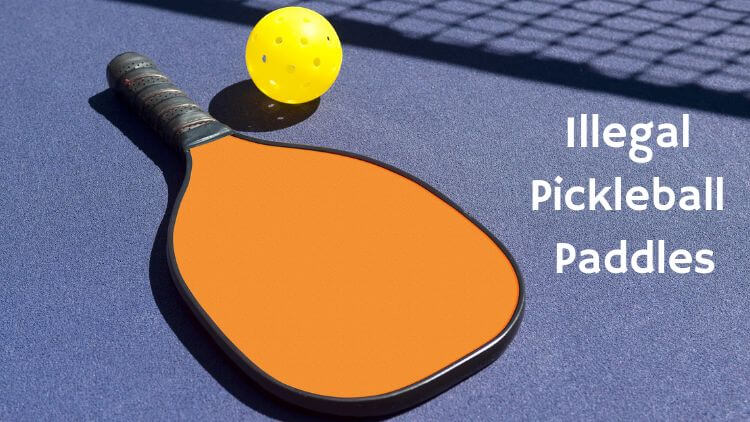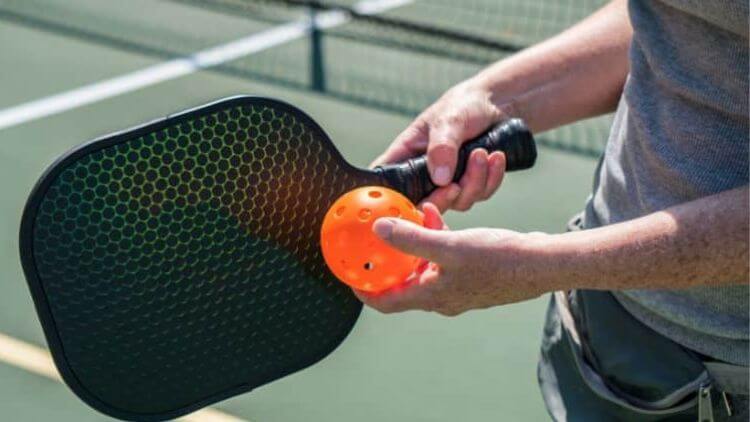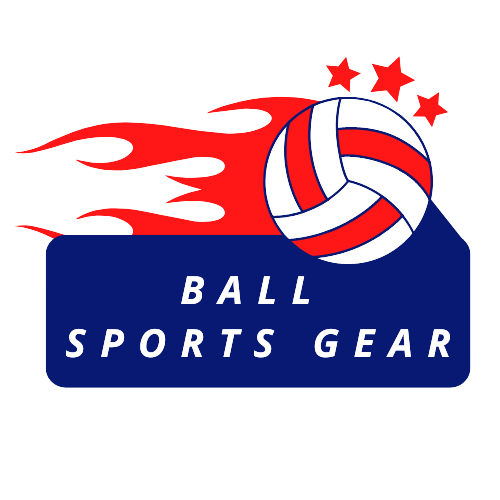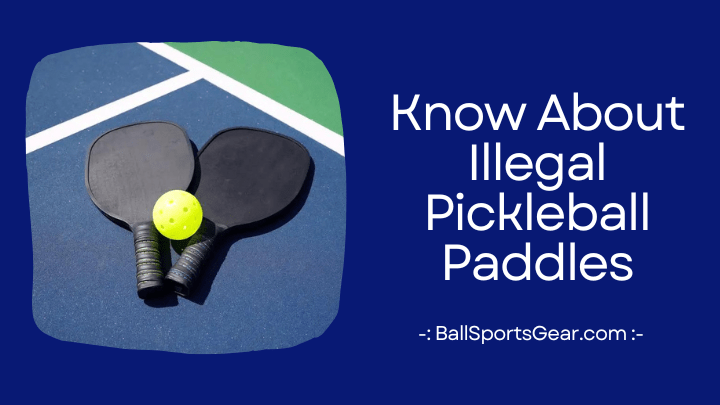In recent years, pickleball has become incredibly popular, drawing players of all ages and abilities. The pickleball paddle is one of the key components of the sport and is very important in determining a player’s success. The equipment used in legitimate pickleball matches is subject to a number of laws and restrictions since not all paddles are created equal. In order to provide players with a fair and equitable playing field, we shall examine in this article the elements that may render a pickleball paddle unlawful.
What Makes a Pickleball Paddles Illegal?
Discover the factors that can deem a illegal pickleball paddles in official matches. From prohibited materials and design irregularities to size and weight restrictions, learn how modifications and customization can also render a paddle ineligible. Understanding the regulations ensures fair play and upholds the integrity of the game. Stay informed to avoid using an illegal pickleball paddles and enjoy a level playing field in pickleball. Let’s understand what makes a pickleball paddles illegal?
Paddle Materials:
The materials used in constructing a pickleball paddle play a significant role in its legality. Official pickleball paddles must have a solid, non-compressible surface. Common materials used include wood, composite, and graphite. However, certain materials, such as metal or glass, are not allowed due to safety concerns and their potential to damage the pickleball or injure players during play. It’s important to ensure that your paddle is made from approved materials to avoid any issues during official matches.
The Paddle’s Design:
The design of a pickleball paddle also contributes to its legality. Paddles must have a flat hitting surface, with no indentations, irregularities, or surface enhancements. The face of the paddle should be smooth and not have any holes, slots, or patterns that could alter the flight of the ball. Furthermore, the edge of the paddle must be free from any attachments or protrusions that could interfere with the game. The design of the paddle is crucial to maintaining fairness and consistency in pickleball matches.
The Paddle’s Size and Weight:
To ensure a level playing field, choose a pickleball paddle that must adhere to specific size and weight requirements. According to official regulations, the paddle’s length, including the handle, must not exceed 17 inches. The width should be within 7.5 inches, and the total weight should not exceed 8.5 ounces. These measurements ensure that all players have access to paddles of similar dimensions, preventing any unfair advantages. Additionally, the thickness of the paddle must not exceed a certain limit to maintain the integrity of the game.

Modification and Alteration:
Modifying or altering a pickleball paddle can render it illegal for official play. This includes changing the materials, altering the dimensions, or adding any attachments that may affect the paddle’s performance. Any unauthorized modifications can give players an unfair advantage or compromise the safety of the game. It is crucial to use paddles in their original, unmodified state to comply with regulations and ensure fair play.
Customization Regulations:
While pickleball paddles can be customized to suit individual preferences, there are certain regulations governing these modifications. Players are typically allowed to add grip wraps or overgrips to enhance their hold on the paddle. However, any alterations that change the paddle’s performance, such as adding weight, altering the surface texture, or using unconventional grip styles, are not permitted. It’s essential to strike a balance between customization and adherence to the rules to avoid using an illegal paddle.
How to Find a Usapa Approved Pickleball Paddle?
If you’re looking to find a USAPA-approved pickleball paddle, there are several steps you can take to ensure you’re purchasing the right equipment. Here’s a guide to help you find a USAPA-approved pickleball paddle:
Research USAPA-approved paddles: Visit the official website of the United States of America Pickleball Association (USAPA) and look for their list of approved paddles. The USAPA provides a comprehensive list of paddles that meet their standards and are allowed in official play.
Check paddle specifications: Look for paddles that meet the USAPA’s requirements in terms of materials, design, size, and weight. Ensure the paddle you’re considering complies with the rules and regulations set by the USAPA.
Read product descriptions and labels: When shopping for pickleball paddles online or in-store, carefully read the product descriptions and labels. Look for mentions of USAPA approval or compliance with official regulations. Reputable manufacturers will often highlight if their paddles are USAPA-approved.
Consult with pickleball communities and experts: Engage with the pickleball community through forums, social media groups, or local clubs. Seek recommendations from experienced players or coaches who can guide you towards USAPA-approved paddles. They may have insights into specific brands or models that are popular among players.
Purchase from authorized dealers: Stick to purchasing from authorized dealers or reputable sporting goods stores. These outlets are more likely to carry USAPA-approved paddles and can provide accurate information about the equipment they sell. Be cautious when purchasing from unknown sellers or online marketplaces, as they may not offer reliable products.
Look for USAPA seal: USAPA-approved paddles often feature a USAPA seal or logo on the paddle face or handle. This seal indicates that the paddle has been tested and approved by the association. Check for this seal when examining or purchasing a pickleball paddle.

Contact the manufacturer: If you have a specific paddle in mind and want to confirm its USAPA approval, reach out to the manufacturer directly. They should be able to provide you with accurate information regarding the paddle’s compliance with USAPA standards.
By following these steps, you can confidently find a pickleball paddle that is USAPA-approved, ensuring that you’re using equipment that meets the official regulations and is suitable for official play.
Frequently Asked Questions
A: Several factors can make a pickleball paddle illegal, including the materials used, design irregularities, size and weight deviations, unauthorized modifications, and non-compliance with customization regulations.
A: Design irregularities such as indentations, surface enhancements, holes, slots, or patterns that alter the flight of the ball can make a paddle illegal. Additionally, paddles with attachments or protrusions on the edge are not permitted.
A: Pickleball paddles are subject to weight and dimension limitations. The whole length of the paddle, including the handle, should not be more than 17 inches. The breadth must not exceed 7.5 inches, and the whole weight must not be more than 8.5 ounces.
A pickleball paddle may become unlawful if unauthorised modifications or adjustments are made to it. This includes altering the components’ composition, size, or addition of extras that could have an impact on the paddle’s functionality.
A: Customization is permitted to some extent, but it is subject to rules. In order to improve their grip on the paddle, players often apply grip wraps or overgrips. Any modificat’
ions that materially modify the paddle’s functionality or grip design, however, could not be allowed.
Conclusion
Understanding the regulations surrounding pickleball paddles is vital for players who wish to compete in official matches. By adhering to the guidelines regarding paddle materials, design, size, weight, modifications, and customization, players can ensure fair play and maintain the integrity of the game.
Pickleball illegal paddles can provide an unfair advantage or compromise the safety of players, making it crucial to familiarize oneself with the rules and use approved equipment. By playing by the book, players can enjoy a level playing field and fully experience the joy and competitiveness of pickleball.

